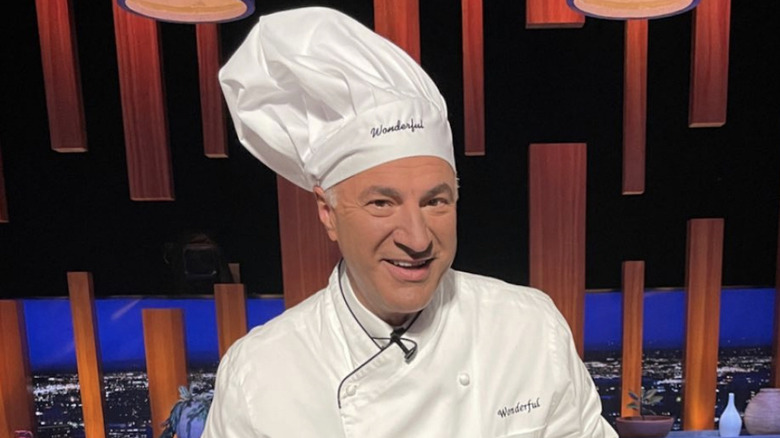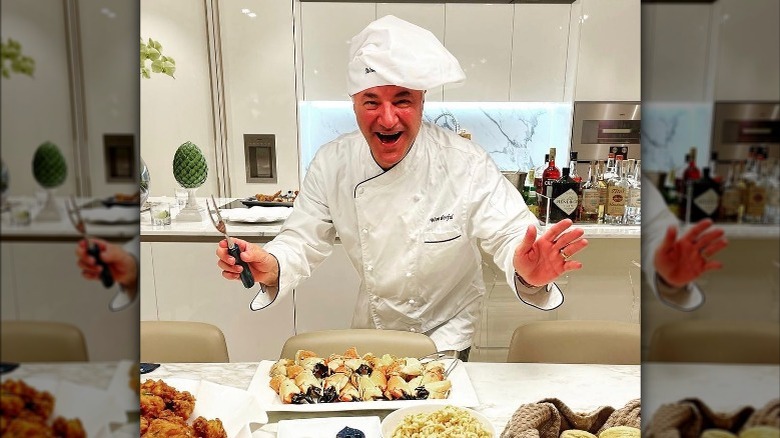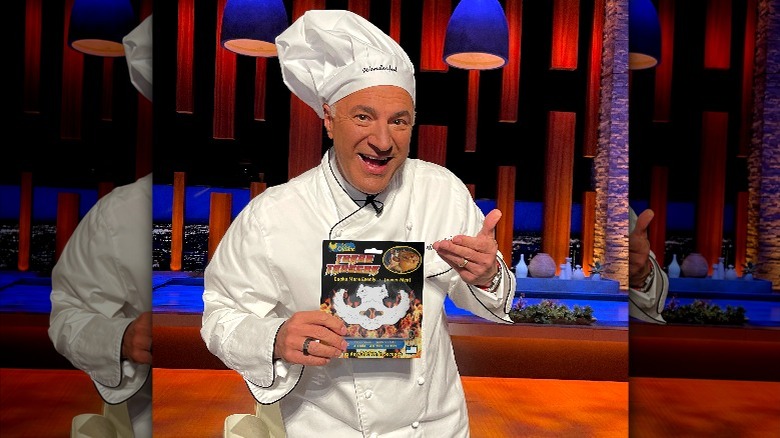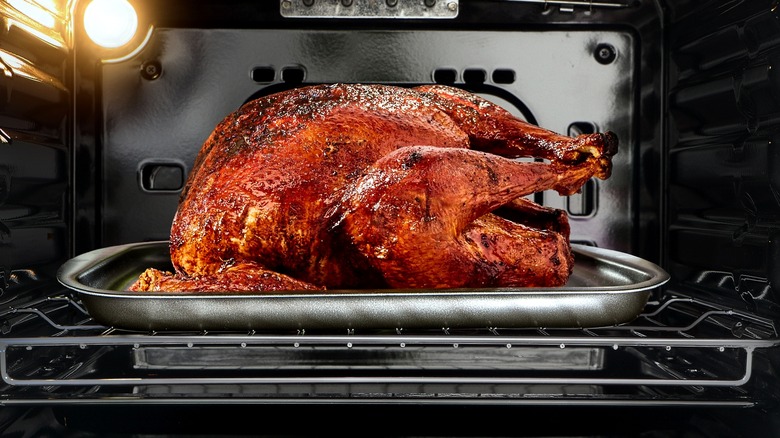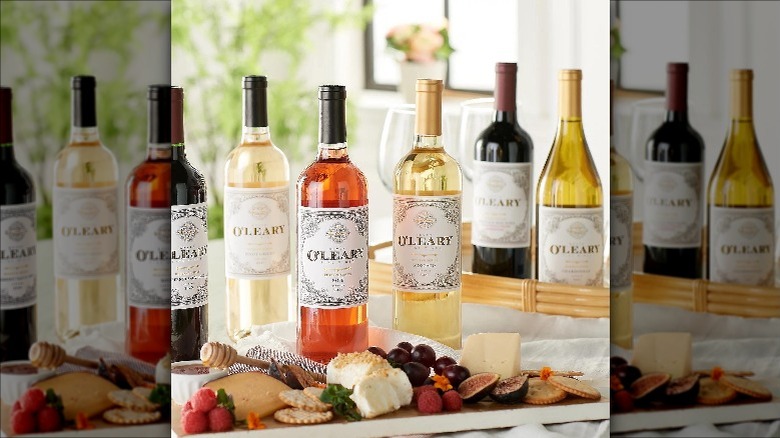Shark Tank's Chef Wonderful Makes His Own Rules In The Kitchen, With Delicious Results - Exclusive Interview
Kevin O'Leary may be primarily known for his investing prowess and business acumen, but the longtime "Shark Tank" investor has another passion besides building brands and making money. He's also known as Chef Wonderful, and not only because he's keen to invest in brilliant up-and-coming food businesses. He also happens to be a skilled cook, with a lifetime of practice and a unique culinary perspective thanks to his background.
Just like he is in the boardroom or on "Shark Tank," O'Leary is not afraid to speak his mind on the things he knows well. Chef Wonderful is highly confident in his cooking talents, whether it's a Lebanese lamb dish from his childhood, a simple roast chicken for dinner guests, or an epic roast beef for the whole staff of "Shark Tank." And he was more than willing to discuss his opinions and insights on all things food.
In an exclusive interview with Mashed, Chef Wonderful opened up about his cooking background and revealed some of his top tips, tricks, and even tools for making the ultimate roast chicken and turkey. The culinary-minded investor also shared some of his favorite ways to cook and pair his line of O'Leary wines with food. O'Leary then dished on what makes for a successful food pitch on "Shark Tank" and shared the story behind one of the worst ideas he ever encountered on the show.
Kevin O'Leary's cooking background spans global cuisine
I was a little surprised to know how seriously you know your way around a kitchen. How did you get into cooking? Where did you learn how?
When I was young, my original father died when he was 37. My mother remarried my stepfather, who joined the United Nations, and we moved to different countries every two years — Cambodia, Ethiopia, Tunisia, Cypress, Japan, Germany, Switzerland.
Notably, in Cambodia, it was the late '60s, and we had a team of chefs. They were Khmer Rouge chefs. And because it's so hot, people would go to the market before sunrise — at 3:30, 4:00 in the morning — [to] get the fresh produce and fish from the Mekong Delta. [It was] incredibly interesting food, but they wouldn't cook with cream. They cooked with mango chutney and lime and lemon extract because everything would spoil if you used milk or cream. [Our housekeeper] would take me to the market with her ... and I would come back in the kitchen when I was only 7, 8 years old, and I learned how to basically become a sous chef.
I didn't realize at the time ... I always thought everybody did that. I didn't know that anybody else lived any other way. I really got into it, and as I grew up, I sort of made it a career. I put myself through college as a chef in the kitchen. I catered weddings; I studied hard; I got my whites. And I still cook today a lot. My whole thing, which has become very popular of late, is how to fuse different cultures' foods and textures and tastes into North American cooking.
I learned the old-fashioned way. I'm half Lebanese and half Irish, and those are completely different cultures. I can make a mutton stew that'll knock your socks off. I also know the delicate ways of Lebanese [cooking], and wrapping grape leaves around rice and lamb meat — that takes hours.
Given the global influences that you've had throughout your life, how would you describe your cooking style?
Fusion. When I'm in Switzerland with my stepfather, we cook together, and we're doing Burgundian cooking when we're doing that. We [cook] venison, beef, fowl, and all kinds of richer foods. Even when I'm doing that, even when I'm preparing a Burgundian dish, I'll throw in a little mango chutney, which nobody's ever seen before in Burgundy, and they love it. "What is this? How did you make the texture of this?" Basically, my chutney's crunchy. I like to get slightly unripe mangoes when they're still green and chop them up and pickle them, which is what I learned to do on the streets of Cambodia.
O'Leary says to think outside the box, and the cookbook
It's really exciting, all these things that people don't think you can do, when you're not afraid to put things together that typically you wouldn't imagine.
Your worst enemy is a cookbook because you are rigorously looking at exact portions in some dish that's been made the same way for years. Forget about that. Experiment. Try different things. That's the whole art of cooking. It's half art, half science.
You want to stay true to a crème brûlée if you're making a dessert, for example. But there's many ways to attack that, or a beef Wellington. You don't have to only do beef Wellington the way it was done in England for 200 years. You can add elements underneath that pastry that are interesting and a big surprise for people. That's my attitude. Don't be locked in to the recipe, because that is a curse. I don't think I've ever made beef Wellington the same way twice.
What is a unique way we should be making beef Wellington?
What can you bring to beef that shakes it up? Let me give you an example. People always say, "A tart cranberry sauce would only go with turkey or chicken." Have you ever tried it with beef? You can crush cranberries, or use a premade sauce. I like to make my own to put less sugar in it. I coat the beef with this delicate layer of cranberry. It's forbidden, but I don't care. I think it's interesting. Even if you want to put some mustard with it, you can do that.
My point is, the color, the texture is unique. You've never seen it before. That's different. I once made it with thin layers of tart pickles. They say, "You can't do that." Why can't I do that? I can do anything I want. That's the Chef Wonderful way.
The secrets to juicy and flavorful poultry, according to Chef Wonderful
You've said one of your favorite things to make at home is roast chicken or turkey. What is your go-to recipe and preparation method here?
First of all, I've got to give a plug for my favorite "Shark Tank" deal, the Turbo Trusser. This thing is elegantly beautiful and so simple. People ask me all the time, "What is the key to success in roasting a turkey?" I don't care whether you roast it, deep-fry it, put it on the barbecue outside, or use a steam oven. I've seen every attempt to make a bird juicy. The reason a bird loses its juices, particularly in the breast area, even [for] a chicken, is that you didn't truss it properly. The juices leak out as the skin dries in the oven from the cracks around the leg. That's where all of the breast juice spills into the pan and makes the juice, which is great, except you're losing all that moisture.
So how do you truss? A lot of people think, "All I have to do is use twine and seal the legs together at the back of the bird." Not true, because you're leaving the wings out there, and that's where the cracks occur also, on the edge of the wings, whether it's a turkey or a chicken, and all the breast juice comes out. They try and truss the entire body with string, [and it] never works, because it burns off. When it heats up to 325 to 350 degrees Fahrenheit, the string breaks and you're back to where you started.
This is why this is such a genius idea. It trusses the wing to the leg and compresses the bird into one ball of meat, so it's cooking it as a unit. Anybody should try this. It's so inexpensive. You can buy them both at the same time online at turbottrusser.com or go to Amazon and pick them up. It'll change the way you think about the bird.
Now, what I like to do when cooking my birds is something a little different. I use a sauce of a little bit of crushed, fresh garlic — not a lot, I like to say "a hint" — with olive oil and fresh-squeezed lemon. I cover the bird with that. Here's the secret: the spice za'atar, a Lebanese spice of roasted, crushed sesame seeds. I coat the bird in za'atar, then I put it in the oven. That's the secret.
You don't need to dry brine to get the right flavor and texture
Another technique that a lot of people talk about when it comes to getting a flavorful piece of chicken or turkey is dry brining. What are your thoughts on that?
I'm against it. To me, it takes away from the chemistry of the bird. The attempts to inject juice, inject sauce, inject butter — that's not the way that we did it 100 years ago. The bird itself has all the necessary juices within its own fat, if you know how to truss it properly. Putting coating on is really to give elegance to the skin and make it a crispy delicacy, but brine is an addition of a lot of salt. I'm not a fan of that. That's a drying agent. It's controversial.
I've also heard a bit about dismembering turkeys and cooking [the pieces] separately. I'm totally against that because it tells me you don't know what you're doing if you can't cook a leg properly attached to a bird, and you better work a little harder at that.
Then what is the secret to getting a crispy skin every time? Because you need that on the outside.
You do. The key to success is to raise the bird up half an inch on a grate. A lot of people will put it in the oven on the pan or on tin foil, giving 40% of the underbird no chance to get the hot air and crisp.
There's other tricks you can do. I'm against this, though. You can sear it in the oven by turning it over, but you don't need to do that if you cook it properly at 325 to 350 degrees Fahrenheit, slowly.
I'm not against using thermometers, and I'm putting it into the deep end of the breast to make sure you're getting the right temperature when you're cooking it. You will find great success with these simple features. Just raise it up half an inch, three-quarters of an inch. You'll get total crispness everywhere. Make sure the grate is thin because you want as little contact as [possible] with the bird's skin.
Turkey is not just for Thanksgiving, says Chef Wonderful
We're talking about whole roasted turkeys here as well. For a lot of people, turkey's a protein that only shows up in that form on Thanksgiving. What's your favorite way to make turkey throughout the year?
It's a great dilemma because it's a fine meat. It is more around the Easter or Christmas period or Passover time, depending on religion you are, that these birds are brought out and celebrated because of their presentation value — which is why I say dismembering it is insane. Bringing out a platter of chopped-up turkey — that's un-American.
To introduce it to the family during the year, the only way I've been able to pull it off is cookouts and barbecues, where I do legs. I'll be doing the traditional wings and legs [with] sausage — big cookout on Sunday night up at the lake house. I'll sneak in four giant turkey legs, which you can buy separately from your butcher, and coat them in a plum sauce or barbecue sauce. It's the thigh and the leg. They end up being the most popular thing coming off the grill. I don't make a big deal of it; I just put it in the mix. I go through quite a bit of turkey legs during the cookout season.
O'Leary wines are as great for cooking as they are for pairing
As much as you're big into food, you're also very big into wine. Do you have any unique ways that you like to cook with your line of O'Leary wines?
Yes. I have 19 different varietals. I cook everything [with them]. Let me give you an example. I made an omelet this morning, a mushroom ham omelet. When I prepared the mushrooms, I used unsalted butter to brown them. Then I introduced about 5 teaspoons of O'Leary Chardonnay 2020, which is an unoaked chardonnay that, when it reduces, gives a unique [flavor to the] mushrooms.
The secret to a chardonnay is that it doesn't [ruin] the color of the mushroom. Red wine would. It makes it a dark black by the time you reduce the wine, which some people don't like in a fluffy omelet. I'm not combating that beautiful color, because I care about texture and color when I'm cooking, so I prepare that separately. I take it out of the pan after, and I let it cool down. Then I introduce my ham.
With the ham, I'll cook with a little cabernet sauvignon, which does make the ham a little darker but also gives it a unique flavor. Now I've got my chard and my cabernet introduced onto two separate piles. I dice up an onion, and then I introduce these as the egg is solidifying in the cast iron pan. Then I flip it over once. Cheese or no cheese — your decision. I can make half with cheese, half without it.
I made that for some guests that were staying here today. They said, "Why does this taste so good?" It tastes so good because I introduced the flavors they're not used to in an omelet. [If] you go to a greasy spoon, they're not going to put chardonnay onto the mushrooms. My omelets — I hate to be boastful, but I am the best. That's it.
Do you have any tips for pairing poultry and wine?
The rule about pairing wines is there are no rules. You don't have to serve white wine or a Moscato or a pinot grigio or a chardonnay with chicken. You can serve a red wine if you wish. I would recommend the lighter side, a new-world pinot noir from Washington, Walla Walla Valley.
When I serve a meal, I put two glasses in front of every service. At the table, I'm chilling a pinot grigio, a chardonnay, a cabernet sauvignon, and a pinot. That's four different varietals. I say, "Try them all. Experiment. Open your palate up." It's all about experimentation, and I urge everybody, do not place that white for fish and chicken on anybody. Who told you to do that? I'm telling you, don't do that.
The food pitches that stand out on Shark Tank
As a "Shark Tank" investor, you've seen your fair share of unique kitchen gadgets, tools, and foods. Is there a food business or a kitchen tool that you haven't seen yet that you would love to invest in?
I've seen everything. I've seen every single kitchen idea in the last 15 years on "Shark Tank." But I will say this to everybody: Very few of these kitchen gadgets do you use a second time. What are the go-to things that I use every day? I'm very particular about my knives. I only use Japanese steel. They're very expensive; they're honed for me. ... They've been with me for decades. That's a huge tool.
The other thing is that I do a lot of work with delicate foods. I cook with a lot of caviar. When you work with caviar and you understand its texture, particularly good caviar, you need to spoon it with mother-of-pearl. You don't put metal near that. I have a set of mother-of-pearl utensils for how I actually work with my caviar. They [have] never seen a metal blade. The introduction of iron oxide to the delicacy of the egg destroys its taste.
[I use] a zester, because I use a lot of zest off lemon. These are basic kitchen utensils. But all of this mechanical stuff, I never use it. Once you get into your rhythm of cooking, you don't need new gadgets. You need to know what works.
What does make for a successful food pitch on "Shark Tank"?
I always say to the people that do this, think about a family — how busy they are and how the day is chewed up with the kids going to school or soccer practice or whatever. Families are jammed. You need great ideas that you can whip up in 30 minutes, 20 minutes, whether it's breakfast, lunch, or dinner.
The stuff that really flies on "Shark Tank" is our food preparations that have three basic things: less cane sugar, less sodium, less gluten. People care about this stuff. And what is the caloric count of what you're proposing? There's nothing wrong with a little sin food, a crazy dessert, a key lime pie, but the basic dishes that are getting a lot of attention are recipes that can be made quickly or are already frozen.
Another area we do a lot of work in is healthier snacks. They're the ones that are getting tremendous traction in a lot of deals because that's where people want to go. Snacking with healthier options now is a multi-billion-dollar industry. That's what I'm looking for.
The worst food pitch on Shark Tank
Does anything specific come to mind if I ask you the worst or the most outrageous pitch that you've turned down on "Shark Tank" related to food?
Tell me what [you think], and I'll tell you the story behind it.
I will never get over the Wake N' Bacon.
There are very stupid ideas, and then there are very, very stupid ideas, and then there are legendary stupid ideas. And I thought that was in the top-ranked [category], legendary stupid. In fact, it was so stupid that I wanted to buy the alarm clock, the prototype, and put it in a frame in my home saying, "This is sheer stupidity." Imagine burning down your house in the morning with grease fat that's on fire beside your bed. I love it. And he wouldn't sell me the prototype at any price. We got into a bidding war. Everybody wanted that stupid thing.
Working with Chef Wonderful means delicious meals on set
Do you ever cook for your fellow "Shark Tank" investors? Do they have any favorite dishes of yours?
Yes, I do. Recently, I've been getting into sous vide, and I'm doing some interesting things with veal and beef. They had never tried sous vide before, and I cooked a giant roast sous vide style, with some cranberry in there. I brought it to the set at 6:00 in the morning with my Chef Wonderful outfit on. I set up a butcher block, and there's 240 people on that set, and I carved the roast in very thin slices on toast. We scarfed down 12 pounds of roast beef before 8:00 in the morning. People went crazy for it. That was cooking for the entire "Shark Tank" set. And by the way, I served chardonnay at 8:00 in the morning. Won't ever do that again.
Obviously, you're Mr. Wonderful and you're the best, but who would you say is the second-best cook on "Shark Tank"?
I will be honest: Barbara Corcoran. She's a very good cook. When I go to New York, she cooks for me in her condominium in New York City. I respect her cooking because she knows what she's doing. The rest have no idea.
This interview has been edited for length and clarity.
Learn more about the Turbo Trusser on its website. Follow the latest from Chef Wonderful on Instagram, and catch episodes of "Shark Tank" on Fridays at 8 p.m. ET/7 p.m. CT on ABC.

